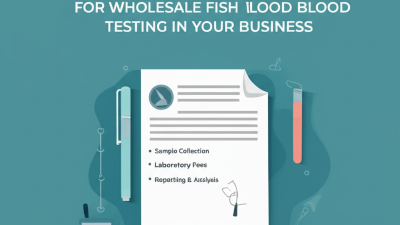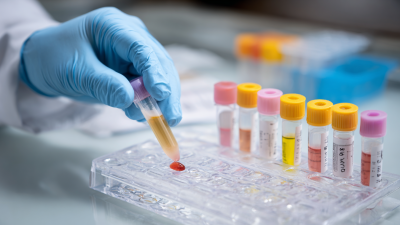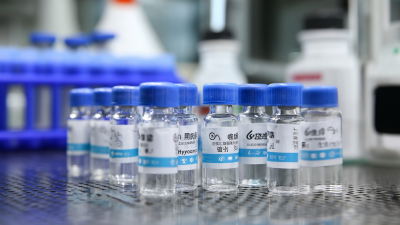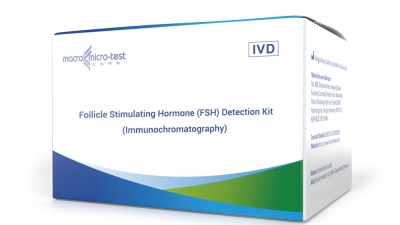Understanding the Cost Factors for Wholesale Fish Blood Testing in Your Business
Table of Contents
- Factors Influencing Wholesale Fish Blood Testing Costs in Your Business
- Understanding the Role of Technology in Fish Blood Testing Expenses
- Comparative Analysis: In-House Testing vs. Outsourcing Costs
- Key Variables Affecting Fish Blood Testing Price Structures
- Best Practices to Optimize Your Fish Blood Testing Budget
- Regulatory Compliance Costs in Wholesale Fish Blood Testing
- Unlocking the Secrets of Follicle Stimulating Hormone (FSH): A Comprehensive Guide to Its Role in Health and Wellness
- FAQS
- Related Posts
Hey, you know, in the fast-changing world of seafood, getting a good handle on the costs of wholesale fish blood testing is pretty important for businesses that want to keep things top-notch and stay compliant. I read somewhere that the global seafood testing market might hit around 25 billion USD by 2026—that’s a huge jump, mainly because people are more concerned about food safety these days and regulations are tightening up. Jiangsu Macro & Micro-Test Med-Tech Co., Ltd. has been leading the way in this space since 2010 — they focus on creating innovative diagnostic reagents and testing tech. As seafood consumers become more curious and want more info about what they’re buying, companies really need to invest in trustworthy fish blood testing methods to avoid risks and stay competitive. Knowing what drives the costs of wholesale fish blood testing can help streamline operations and make sure the products are of high quality. Basically, it's all about being transparent, efficient, and keeping the market happy.

Factors Influencing Wholesale Fish Blood Testing Costs in Your Business
If you're involved in the wholesale fish industry, you already know that staying on top of the costs associated with blood testing is pretty important for running things smoothly. Things like what testing methods you use, how fancy your lab equipment is, and how many samples you process can really add up and affect your overall expenses. Sure, going for the latest tech might cost more upfront, but in the long run, it often pays off with better accuracy and efficiency. Plus, if you're able to keep a steady flow of samples, you can lower the cost per test—which just goes to show how planning your testing schedule and volume really makes a difference.
And speaking of costs, the quality and sourcing of testing reagents really matter, too. Companies like Jiangsu Macro & Micro-Test Med-Tech Co., Ltd. are leading the way with innovative diagnostic reagents that are specifically designed for the fishing industry. As more businesses start to care about quality and reliability, choosing the right supplier becomes a big deal—since prices can vary quite a bit depending on the technology they use and their level of expertise. Managing these cost factors wisely not only helps you stay compliant with health regulations but also boosts the overall quality of your products. In the end, it’s all about making smarter choices that benefit the whole supply chain in the wholesale fish game.
Understanding the Role of Technology in Fish Blood Testing Expenses
You know, in the seafood industry, dealing with wholesale fish blood testing can get pretty complicated. Technology plays such a huge role now, especially when it comes to managing costs. These days, there are some pretty cool advanced testing methods that use the latest tech to make blood analysis not only more accurate but also quicker and more efficient. That’s a game-changer for keeping quality up and making sure everything’s on the up-and-up with health regulations. For example, automated testing systems can cut down on labor costs and speed things up—giving businesses a real edge, especially in such a fast-moving market.
Plus, bringing technology into the mix doesn’t just make the testing simpler; it also boosts how we gather and analyze data. With all that info at hand, farms can fine-tune feeding routines and nutrition plans—something that’s particularly gaining attention in East Africa’s fish feed sector. Tools like biofloc technology are great examples; they help optimize resource use, cut waste, and lower operational costs overall. As the industry faces ongoing issues like water pollution and nutritional needs, embracing these tech upgrades in fish blood testing could be a real key to growing sustainably and staying profitable. It’s all about evolving with the times, right?
Comparative Analysis: In-House Testing vs. Outsourcing Costs
When it comes to wholesale fish blood testing, businesses often have to choose between doing it in-house or outsourcing, and each route comes with its own cost considerations. Industry reports suggest that setting up your own testing facilities can get pretty pricey upfront — we're talking equipment costs and maintenance, which might end up being 50% or even more over what you'd initially plan for. This is especially true for companies like Jiangsu Macro & Micro-Test Med-Tech Co., Ltd., who are all about innovative detection tech. For them, it might make more sense to put their resources into R&D rather than getting bogged down in testing logistics.
On the flip side, outsourcing the testing process can actually save a good chunk of change. Some comparisons show that outsourcing could cut testing costs by about 30-40%, mainly because you skip the need for hiring specialized staff and investing in pricey infrastructure. By 2025, many industry leaders plan to lean on outsourcing as a strategic move — letting them better allocate resources and simplify their operations. Plus, with testing regulations around fish safety getting stricter, working with dedicated testing providers isn't just about saving money — it also helps improve accuracy and reliability, which leads to better results all around.
Key Variables Affecting Fish Blood Testing Price Structures
When you’re looking into wholesale blood testing for your fish business, there are quite a few factors that can really influence the price. One of the biggest things is the kind of test you need. Some tests check for things like oxidative stress, disease markers, or overall health — and because each of these looks at different stuff, their costs can vary pretty a lot. Plus, how sophisticated and sensitive the testing methods are also matters. For example, more advanced techniques like molecular diagnostics or high-throughput screening tend to be pricier than your standard biochemical tests.
Another thing to keep in mind is the volume of samples you’re dealing with. If you’re running larger batches, you often get a better deal per sample — so it’s worth thinking about how often you’ll need testing and how many samples you’re planning to process. Many suppliers have tiered pricing, which means if you commit to bigger orders, you can save quite a bit. Also, where you’re located and how samples are shipped can impact costs and turnaround times, which might affect your overall budget.
Getting a handle on these factors can really help you make smarter decisions that match your budget and operational needs. It’s all about understanding what goes into the pricing so you can plan accordingly and avoid surprises down the line.
Best Practices to Optimize Your Fish Blood Testing Budget
Keeping an eye on your fish blood testing budget is super important if you wanna keep things running smoothly and maintain the quality of your products in your wholesale fish business. Thanks to new tech, like Environmental DNA (eDNA) analysis, there are smarter ways to do your testing and potentially cut down on costs. Trying out these newer methods can give you more precise results especially in your local environment, which means you don't end up doing unnecessary tests and wasting money.
So, here's a good tip: take a moment to review your current testing routines. If it makes sense, try adding eDNA techniques where they fit. These methods can help you assess biodiversity more effectively and might mean ditching some of those more expensive traditional tests.
And another thing — don’t forget to keep tabs on your suppliers and shop around for the best deals. Building good relationships with labs that offer discounts for bulk testing can really save you a bunch in the long run.
Plus, it’s smart to stay on top of the industry’s latest practices, especially when dealing with stuff like fish louse outbreaks. Combining smart testing choices with continuous learning about aquaculture innovations means you can keep costs in check and make sure your fish are healthy and happy. It’s all about staying ahead of the game!
Regulatory Compliance Costs in Wholesale Fish Blood Testing
In the wholesale fish business, dealing with regulatory stuff like blood testing can really add to your costs—and that can make a big difference in how smooth your operations run. The FDA, for example, stresses the importance of regular testing to check for pollutants like mercury and other nasty substances in fish. I’ve come across reports saying that these compliance expenses can make up to 15% of a company's overall operating costs in certain parts of the market, which means businesses really need to plan and set aside enough resources to stay on top of these rules.
Plus, the rules aren't the same everywhere—some regions are way more strict than others, which can bump up your costs even more along the supply chain. Take the European Union, for instance—data from the European Food Safety Authority shows that companies there often face higher compliance costs thanks to tighter testing standards and inspections. These can include lab fees, staff training, and quality control measures, which, for medium to large wholesale outfits, can add up to over $20,000 a year. So, it's pretty clear that understanding these costs and budgeting for them is crucial if you want to stay competitive in the wholesale fish market.
Unlocking the Secrets of Follicle Stimulating Hormone (FSH): A Comprehensive Guide to Its Role in Health and Wellness
Follicle Stimulating Hormone (FSH) is a crucial player in the endocrine system, primarily responsible for regulating reproductive processes in both men and women. In females, FSH stimulates the growth of ovarian follicles, essential for ovulation, while in males, it assists in sperm production. According to the Endocrine Society, FSH levels fluctuate across different stages of life, with peak levels observed during the reproductive years, highlighting its role in fertility. Understanding FSH levels can provide valuable insights into various health conditions, including infertility, polycystic ovary syndrome (PCOS), and menopause.
For those looking to monitor their FSH levels conveniently, an in vitro qualitative detection product specifically designed for the assessment of FSH in human urine is now available. This product serves as a vital tool for individuals seeking to understand their hormonal health better. By offering rapid and accurate results, it empowers users to make informed decisions regarding their reproductive health. Industry data supports the significance of regular hormonal monitoring, noting that imbalances in FSH can signal underlying health issues that warrant further investigation or intervention.
Research indicates that maintaining optimal FSH levels is essential not just for reproductive health but also for overall wellness. Anomalies in FSH levels can correlate with various medical conditions and, therefore, proactive monitoring can aid in early detection and treatment. As more individuals become aware of the importance of health monitoring, tools for accessing hormonal insights like FSH detection will play a pivotal role in personal health management.
FAQS
: In-house testing can incur substantial upfront costs, including equipment purchases and maintenance, which may total upwards of 50% more than anticipated operational budgets. Outsourcing can lead to savings of 30-40% by eliminating the need for specialized personnel and infrastructure investment.
Companies like Jiangsu Macro & Micro-Test Med-Tech Co., Ltd. may find it more beneficial to concentrate their resources on innovative detection technologies and research and development rather than the logistics associated with testing.
Partnering with dedicated service providers for outsourced testing can not only lower costs but also improve testing accuracy and reliability, which is crucial given the increasing complexity of regulatory compliance in fish safety testing.
Implementing technologies such as Environmental DNA (eDNA) analysis can streamline testing processes and reduce costs by achieving more accurate results and minimizing unnecessary testing.
Businesses should review their current testing protocols and consider integrating eDNA methods where applicable to advance biodiversity assessments and decrease reliance on traditional costly testing methods.
Regularly assessing suppliers and negotiating terms, as well as establishing strong relationships with labs that offer bulk testing discounts, can significantly lower overall testing costs.
Industry leaders expect that leveraging outsourcing will allow them to allocate resources more efficiently and streamline operations, providing a strategic advantage in the competitive market.
Staying informed about industry best practices and advancements in aquaculture can help businesses optimize cost management and ensure the health of their aquatic stock, especially when addressing challenges like fish louse epidemics.
Related Posts
-

The Future of Rapid Testing Solutions for Malaria Wholesale Suppliers
-

Chinese Excellence in Manufacturing Best Malaria PV Driving Global Supply Chain Solutions
-

Exploring the Features and Applications of Cervical Cancer Self Test Kits: A Comprehensive Guide
-

Discover Top-Quality Hpylori Test Solutions from Premier Chinese Manufacturers
-

Future Trends in Gene Cyp2c19 Market Analysis for 2025 and Beyond
-

The Future of Best tt3 Innovations in Efficiency and Performance


